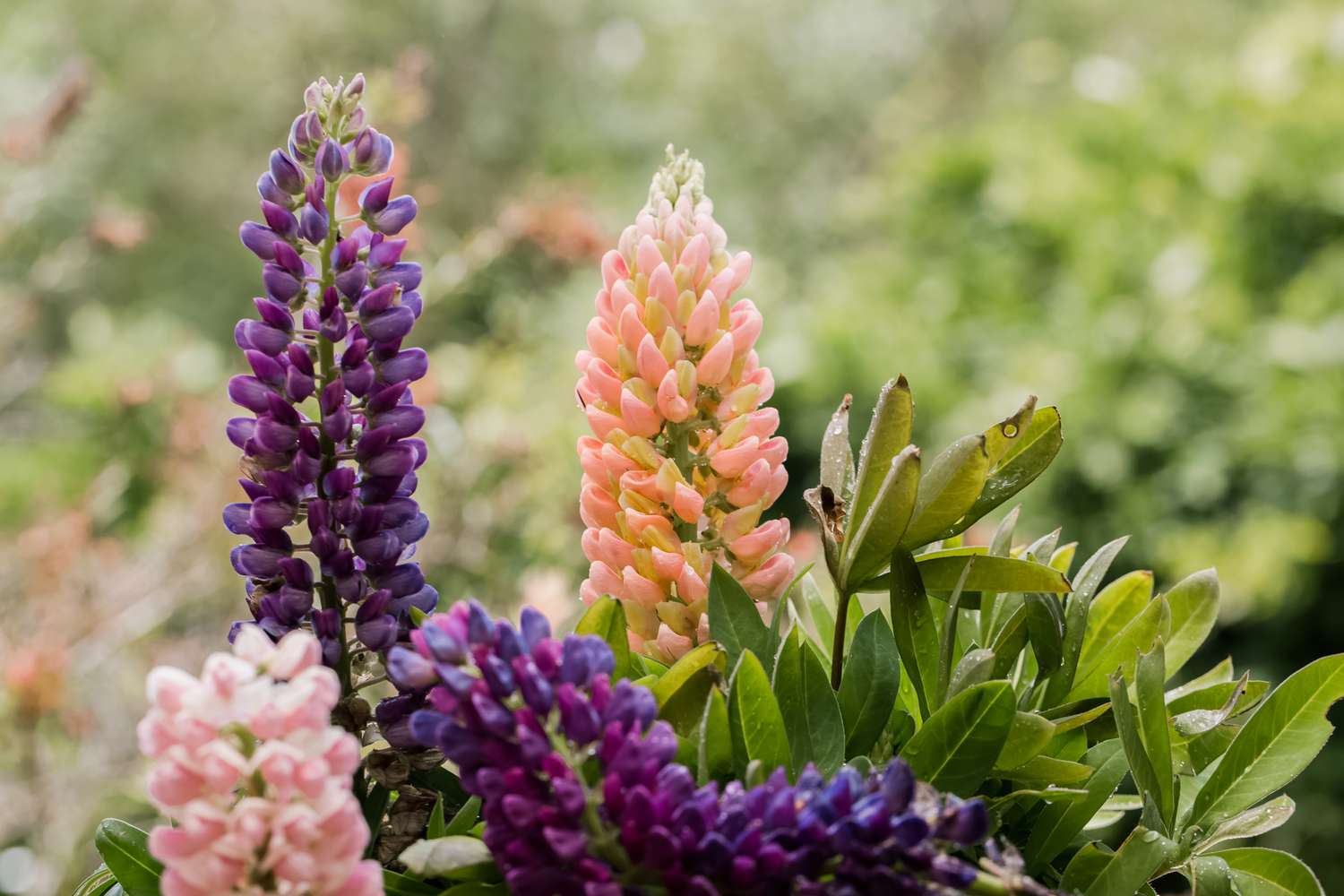Wow! This bright plant mix will make you happy for weeks in late spring and early summer! It includes the beautiful vertical lines of Lupinus ‘Masterpiece’ (Lupine) and Verbascum ‘Southern Charm’ (Mullein), the very showy Camassia ‘Blue Heaven’ (Camass), the glowing Geum ‘Prinses Juliana’ (Avens), and the especially lovely violet-blue blooms of Aquilegia vulgaris var. stellata ‘Blue Barlow’ (Columbine).
Lupines are stunning perennial flowers that bloom in late spring and early summer. Their spiky towers come in a variety of colors like purple, yellow, white, pink, blue, and even bicolors. Lupines grow 1-3 feet tall and wide, making them ideal for backgrounds and cottage gardens.
While lupines make beautiful standalone plants, they also pair wonderfully with other flowers, herbs, and vegetation. The key is choosing plants with compatible growing needs and visually complementing colors and textures. Here are some of the best companion plants for lupines:
Shrubs That Complement Lupines
-
Lilacs – These spring-blooming shrubs reach 4-15 feet tall. Choose compact varieties under 6 feet for borders. Their purple flowers pair nicely with purple and pink lupines.
-
Weigela – Weigela shrubs grow 4-6 feet tall with pink, red, or white spring flowers. They contrast well with blue and yellow lupines.
-
Rose of Sharon – At 6-12 feet tall, rose of Sharon serves as a mid-border background shrub. Its summer blooms coordinate with late-season lupines.
-
Roses – Bush roses and climbing roses offer a variety of flower colors. Focus on varieties under 5 feet tall for borders.
Perennials That Flower Alongside Lupines
-
Bee Balm – With its shaggy pink, red, or purple blooms, bee balm complements lupines in cottage and prairie gardens It grows 2-4 feet tall.
-
Sea Holly – The unique prickly texture of sea holly’s blueflower heads contrast nicely with lupines’ smooth leaves and flowers. It reaches 1-3 feet tall.
-
Garden Phlox – Phlox paniculata offers summer-blooming white, pink, purple, and red flowers on 2-4 foot tall plants. It suits casual cottage gardens with lupines.
-
Blazing Star – These late summer wildflowers have purple, pink, or white spikes reaching 1-5 feet tall. They extend the season after lupines finish blooming.
-
Peonies – The lush, full blooms of peonies complement lupines’ vertical spikes. Choose herbaceous or intersectional peonies in white, pink, red, or yellow.
-
Bearded Irises – Tall bearded irises come in a huge range of colors. They make ideal partners for lupines since they bloom at the same time and grow 1-3 feet tall.
Annuals For Colorful Lupine Companion Planting
-
Sunflowers – Cheery sunflower flowers pair perfectly with lupines. Choose short varieties like ‘Elf’ or ‘Honeycomb’ for borders.
-
Marigolds – Marigolds are available in orange, yellow, white, and multi-colors. The compact French marigold varieties work well with lupines.
-
Zinnias – These heat-loving annuals bloom through summer in colors like red, pink, orange, yellow, white, and striped. Try the ‘Profusion’ series 6-12 inches tall.
-
Angelonia – Sometimes called “summer snapdragons,” angelonia produces purple, white, or pink flowers on 12-30 inch upright plants suited for backgrounds.
-
Salvia – The tall flower spikes of salvia nicely echo those of lupines. Look for purple, red, pink, white, or blue varieties like ‘Evolution Violet’ or ‘Mystic Spires Blue.’
Herbs and Vegetables That Grow Well With Lupines
-
Chives – The round lavender flower heads of chives contrast with pointy lupine spikes. The grassy leaves also make a nice texture pairing.
-
Oregano – Bushy oregano plants bear pink or white flowers in summer. The bees will thank you for planting oregano and lupines together!
-
Thyme – Low-growing creeping thyme suits the front of lupine borders. Go for lemon thyme or silver thyme for colorful foliage.
-
Mint – Choose compact mint varieties like Corsican mint. The tiny mauve flowers and fragrant foliage complement lupines’ colors and bee popularity.
-
Beans – Pole beans and bush beans fix nitrogen in soil, benefiting nitrogen-loving lupines. Plus, the bean flowers attract pollinators.
-
Carrots – The ferny foliage of carrots contrasts nicely with lupines’ bold leaf shapes. Plus, lupines’ roots help loosen soil for the carrots.
Best Companion Plants for Lupines In Containers
Container plantings let you combine lupines with trailing plants like:
-
Ivy geraniums – Red, pink, purple, or white ivy geraniums spill attractively over pot edges, contrasting with upright lupines.
-
Calibrachoa – Also called million bells, these prolific bloomers come in blue, purple, pink, yellow, orange, red, and white.
-
Bacopa – This low-growing trailing plant bears abundant tiny white blooms. It handles heat well.
-
Dichondra – The small, rounded silver or green leaves of dichondra make a living mulch under lupines. Choose ‘Silver Falls’ for its cascading habit.
-
Thyme – In addition to its culinary uses, thyme makes an attractive lupine container companion. Go for trailing woolly thyme or elfin thyme.
Plants to Avoid Growing with Lupines
While lupines pair well with many plants, a few options are best avoided:
-
Shade lovers – Lupines need full sun, so don’t plant them near trees/shrubs that will block light as they mature.
-
Water-lovers – Lupines prefer drier soil, so bog plants won’t work well. Avoid cardinal flower, astilbe, ligularia, and other moisture lovers.
-
Aggressive spreaders – Lupines self-seed readily, so avoid pairing them with mint, lemon balm, Jerusalem artichokes, or other fast spreaders.
-
Short plants – Lupines grow tall and may overwhelm slow-growing, short plants. Don’t combine lupines with creeping phlox, primroses, or violas.
Tips for Successful Lupine Companion Planting
Here are a few handy tips to get the most out of combining lupines with other plants:
-
Stick to the same soil, sun, and watering needs for the happiest plant pairings
-
Limit companions to under 3 feet tall to prevent crowding and shading of lupines
-
Deadhead faded lupine flowers to reduce self-seeding
-
Amend soil with compost to provide nutrition for both plants
-
Mass lupines together with companions for a cohesive look
-
Repeat key companion plants throughout the garden for cohesion
With their vibrant, vertical flower spikes, lupines make showstopping focal points and backgrounds in borders, cottage gardens, prairie gardens, wildflower meadows, and even containers. Pair them with shrubs, perennials, annuals, herbs, and vegetables in harmonizing colors and forms. Using compatible, complementary companion plants allows the beauty of lupines to shine while creating a rich tapestry in your landscape.
Plants In This Garden
Lupinus ‘Manhattan Lights’ (Lupine) is a beautiful plant that blooms in late spring to early summer. It has tall, showy spikes of densely packed, sweet-smelling purple and yellow flowers.
| Hardiness | 4 – 8 |
|---|---|
| Exposure | Full Sun, Partial Sun |
| Season of Interest | Spring (Late) Summer (Early) |
| Height | 2 – 3 (60cm – 90cm) |
| Spread | 1 – 2 (30cm – 60cm) |
Bred for cut flower production, Aquilegia vulgaris var. stellata ‘Blue Barlow’ has especially pretty violet-blue flowers that are fully double, facing upward, and don’t have any spurs. They look like starry pompons and bloom in late spring to early summer.
| Hardiness | 3 – 9 |
|---|---|
| Exposure | Full Sun, Partial Sun |
| Season of Interest | Spring (Late) Summer (Early) |
| Height | 2 – 3 (60cm – 90cm) |
| Spread | 1 – 2 (30cm – 60cm) |
Camassia ‘Blue Heaven’ (Camas) is a bulbous perennial plant that has long racemes of up to 100 pale blue flowers that look like stars. Each flower has six showy tepals, a green center, and bright yellow stamens. Borne on stout, willowy stems, they open sequentially from bottom to top for a long-lasting display.
| Hardiness | 3 – 8 |
|---|---|
| Exposure | Full Sun, Partial Sun |
| Season of Interest | Spring (Late) Summer (Early) |
| Height | 2 – 3 (60cm – 90cm) |
| Spread | 1 – 2 (30cm – 60cm) |
Verbascum ‘Southern Charm’ is a short-lived perennial that grows large, graceful spikes full of flowers in soft shades of peach, lavender, and creamy yellow, each with a fuzzy purple eye. It is a popular ornamental Mullein.
| Hardiness | 5 – 8 |
|---|---|
| Exposure | Full Sun |
| Season of Interest | Spring (Late) Summer (Early, Mid, Late) Fall |
| Height | 2 – 3 (60cm – 90cm) |
| Spread | 1 – 2 (30cm – 60cm) |
Geum ‘Prinses Juliana’ is a clump-forming, herbaceous perennial that looks great in almost any garden or flower arrangement. It has masses of very showy, semi-double, fiery orange flowers that bloom from late spring to early summer.
| Hardiness | 5 – 9 |
|---|---|
| Exposure | Full Sun, Partial Sun |
| Season of Interest | Spring (Late) Summer (Early) |
| Height | 1 – 2 (30cm – 60cm) |
| Spread | 1 – 2 (30cm – 60cm) |
Salvia nemorosa ‘Caradonna,’ a plant that has won many awards, is a favorite among gardeners because of its beautiful, glowing dark purple stems and tall spikes of rich, violet-blue flowers that bloom in late spring or early summer.
| Hardiness | 4 – 9 |
|---|---|
| Exposure | Full Sun |
| Season of Interest | Spring (Late) Summer (Early, Mid) |
| Height | 1 – 2 (30cm – 60cm) |
| Spread | 1 – 2 (30cm – 60cm) |
Alternative Plants to Consider
| Hardiness | 4 – 8 |
|---|---|
| Heat Zones | 5 – 8 |
| Climate Zones | 3, 4, 5, 6, 7, 14, 15, 16, 17 |
| Exposure | Full Sun |
| Season of Interest | Spring (Late) Summer (Early) |
| Maintenance | Low |
| Water Needs | Average |
| Soil Type | Loam |
| Soil pH | Neutral |
| Soil Drainage | Moist but Well-Drained, Well-Drained |
| Characteristics | Cut Flowers, Showy |
| Attracts | Butterflies, Hummingbirds |
| Landscaping Ideas | Beds And Borders |
| Garden Styles | Informal and Cottage |

Success Growing Lupines | Volunteer Gardener
FAQ
What plants go well with lupines?
Can you plant lupine with vegetables?
What time of year do you plant lupine?
What flowers go well with a lupine?
Delphiniums ( Delphinium spp.) – These tall, spiky flowers add height and a variety of colors to the garden, complementing the Lupines’ tall flower spires. Foxgloves (Digitalis spp.) – Foxgloves have similar flower spires and can create a stunning display alongside Lupines. They also attract pollinators and thrive in similar conditions.
How do you plant a lupine plant?
Potted lupine plants are typically perennial cultivars that you can put in the ground immediately in the spring. Space plants about 2 to 3 feet apart, and loosen the soil deeply to accommodate the long taproots. Amend the planting hole with organic matter, if necessary, to improve drainage.
Do lupines make good flowers?
• Lupines make perfect cut flowers and look spectacular in flower arrangements. • These plants can aid moisture retention and protect the soil from erosion. Additionally, they can decrease the need for chemical fertilizers. If you lack ideas on how to use lupines in your landscape, maybe these can help.
Do lupines grow from seeds?
Propagate lupine every 2 to 3 years, as they are short-lived plants. Lupines are among the easiest perennials to grow from seeds. Perennial lupine flowers typically take 2 years to bloom when grown from seed. You can buy seeds or harvest seeds from lupine’s seed pods in the fall. Start lupines from seed in the early to late spring.
- The Ultimate Guide to Growing Strawberries in Raised Beds - August 8, 2025
- No-Dig Garden Beds: The Easiest Way to Grow a Beautiful Garden - August 6, 2025
- How to Protect and Preserve Wood for Raised Garden Beds - August 6, 2025

